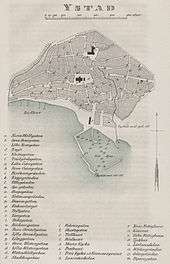Ystad
| Ystad | ||
|---|---|---|
|
Main square with town hall | ||
| ||
 Ystad  Ystad | ||
| Coordinates: 55°25′N 13°50′E / 55.417°N 13.833°ECoordinates: 55°25′N 13°50′E / 55.417°N 13.833°E | ||
| Country | Sweden | |
| Province | Skåne | |
| County | Skåne County | |
| Municipality | Ystad Municipality | |
| Area[1] | ||
| • Total | 8.65 km2 (3.34 sq mi) | |
| Population (31 December 2015)[1] | ||
| • Total | 28,985 | |
| • Density | 2,120/km2 (5,500/sq mi) | |
| Time zone | CET (UTC+1) | |
| • Summer (DST) | CEST (UTC+2) | |
Ystad (Swedish pronunciation: [ˈyːsta]) is a town, and the seat of Ystad Municipality, Skåne County, Sweden, with 18,350 inhabitants in 2010.[1] The settlement dates back to the 11th century and the town has become a busy ferryport, local administrative centre and tourist attraction. It is associated with the fictional detective Kurt Wallander whose stories, by Henning Mankell, are set primarily in Ystad and nearby communities.
In 1285, the town's name was written Ystath. Its original meaning is not fully understood, but the "y" is probably related to an old word for the yew tree,[2] while -stad is town, or place. In Danish times before 1658 the spelling was Ysted.
History

After the time of Absalon, Bishop of Roskilde and Archbishop of Lund, peace was brought to the area in the 11th century, fishing families settled at the mouth of the river Vassa as herring fishing became the main source of trade. Ystad was not mentioned in documents until 1244, in a record of King Eric's visit to the town with his brother, Abel. A Franciscan monastery, Gråbrödraklostret, was founded in 1267, and Ystad joined the Hanseatic League in the 14th century.
The charter of 1599 gave the town the right to export oxen. Ystad, together with all of Scania, was transferred from Denmark to Sweden following the Treaty of Roskilde in 1658.[3][4]
By 1866 Ystad had a railway connection and it was established as a garrison town in the 1890s. After World War II, ferry services to Poland and to the Danish island of Bornholm were opened.
Demographics
In 1658, Ystad's population was about 1,600 and, by 1850 it had reached 5,000. The increased importance brought by the railway and the garrison in the 1890s drove the population above 10,000.[4]
Popular culture
Ystad is the setting of the Swedish crime drama Wallander.
Infrastructure
Economy
Some of the main industries of the town are trade, handicraft and tourism, derived from being one of the best preserved medieval towns in the Scania province and its association with the Wallander detective novels. There is an active port with ferry and train services.
Transport
The ferry port has services to the Danish island of Bornholm and to Świnoujście (formerly Swinemünde), in Poland, forming part of the E65 road route south from Malmö.
The town is on the railway line between Malmö and Simrishamn (operated by Skåne Commuter Rail) and has direct rail services to Copenhagen via the Øresund Bridge (operated by Danish State Railways[5]).
Sports
The most popular sport in Ystad is handball, with two big clubs. Ystads IF is in Elitserien (the highest Swedish men's national league, as of 2008) whilst IFK Ystad is situated in Division 1 (the second highest league, as of 2008). Several famous handball players have played one or other of these clubs, the most famous one probably being Per Carlén.
Media
The only newspaper published at present in Ystad is the Ystads Allehanda, which also covers the neighbouring municipalities of Skurup, Tomelilla, Simrishamn and Sjöbo. The newspaper was founded in 1873.[6]
Places of interest
One of Sweden's most well-preserved medieval monasteries, the greyfriars abbey, lies in Ystad. The town also has an additional large medieval church, the Church of the Virgin Mary (Mariakyrkan). Both are highly influenced by Gothic Hansa architecture (which can also be seen in churches around the Baltic Sea, for instance in Helsingborg, Malmö, and Rostock) and are among the best examples in Sweden of Brick Gothic. In addition, there are areas of surviving medieval town architecture, like the Latin school (built c. 1500) and several town houses. The city is also included in the European Route of Brick Gothic.
Notable residents
- Malik Bendjelloul (1977–2014), documentary filmmaker
- Lykke Li (born 1986), singer-songwriter
- Michael Saxell (born 1956), songwriter, artist and producer
- Richard Andersson (born 1972), musician and songwriter
- Rolf Holmgren (born 1946), actor and scriptwriter
- Ernst-Hugo Järegård (1928–1998), actor
- Börje Langefors (1915–2009), computer scientist
- Gunnar Malmquist (1893–1982), astronomer
- Anna Q. Nilsson (1888–1974), Swedish born American actress
- Sara Li born Sara Linnea Larsson (born 1988), Swedish singer
- Arek Lisowski (born 1980), Swedish-Polish video maker, also known as Keralis
- Frans Jeppsson-Wall (1998), singer.
External links
| Wikimedia Commons has media related to Ystad. |
| Wikivoyage has a travel guide for Ystad. |
References
- 1 2 3 "Tätorternas landareal, folkmängd och invånare per km2 2005 och 2010" (in Swedish). Statistics Sweden. 14 December 2011. Archived from the original on 10 January 2012. Retrieved 10 January 2012.
- ↑ Svenskt ortnamnslexikon, 2003
- ↑ "Ystad's history in a nutshell". Ystads kommun. 2011. Retrieved 5 August 2011.
- 1 2 "Ystads befolkningsutveckling 1570-1995 (Swedish)". cybercity. 2011. Retrieved 6 August 2011.
- ↑ "Øresund trains to Ystad (Danish)". DSB. 24 May 2004. Retrieved 7 August 2011.
- ↑ Ystads Allehanda site

